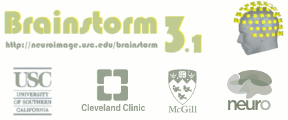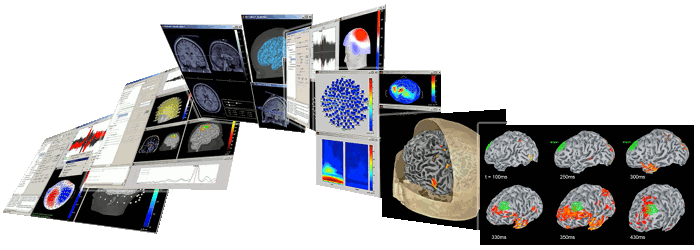|
Size: 7997
Comment:
|
Size: 8885
Comment:
|
| Deletions are marked like this. | Additions are marked like this. |
| Line 1: | Line 1: |
| {{attachment:logo_line.gif}} | <<HTML(<div style="margin-top: 15px; padding: 0px; border: 0px solid #999; float: right; width:310px; "><TABLE Border=0 style="background-color: #f7f7f7;"><TR><TD colspan=2><A href="http://neuroimage.usc.edu/brainstorm/Training">New Brainstorm courses: Register now!</A></TD></TR><TR><TD><B>Boston: </B></TD><TD>April 28, 2012 (FULL)</TD></TR><TR><TD><B>Montreal: </B></TD><TD>July 11, 2012</TD></TR><TR><TD><B>Paris: </B></TD><TD>August 31, 2012</TD></TR></TABLE></div>)>> |
| Line 3: | Line 3: |
| = Welcome! = Brainstorm is a collaborative, open-source application dedicated to magnetoencephalography (MEG) and electroencephalography(EEG) data analysis ('''visualization, processing and advanced source modeling'''). |
{{attachment:logo_bloc.gif|logo_line.gif}} |
| Line 6: | Line 5: |
| {{attachment:brainstorm_banner.gif}} | == News == * '''1st Brainstorm-users Symposium & Training'''<<BR>>Satellite of Biomag2012; Paris, August 31, 2012<<BR>>[[WorkshopBiomag2012|Call for papers & registration]] * '''Latest software updates''' :<<BR>>[[News|http://neuroimage.usc.edu/brainstorm/News]] * '''Join the Brainstorm community now''' :<<BR>> [[http://www.facebook.com/BrainstormSoftware|facebook.com/BrainstormSoftware]] == The Brainstorm project == . {{attachment:brainstorm_banner.gif||height="209px",width="586px"}} Brainstorm is a collaborative, open-source application dedicated to magnetoencephalography (MEG) and electroencephalography(EEG) data analysis (visualization, processing and advanced source modeling). |
| Line 10: | Line 17: |
| Since the project started by the end of the 1990's, our server has registered more than 6,000 software downloads and about 500 users are actively updating the software. See our [[Pub|reference page]] for a list of published studies featuring Brainstorm at work! | Since the project started by the end of the 1990's, our server has registered more than 7,000 accounts and about 500 users are actively updating the software. See our [[Pub|reference page]] for a list of published studies featuring Brainstorm at work! |
| Line 12: | Line 19: |
| The best way to learn how to use Brainstorm, like any other academic software, is to benefit from local experts. However, you may be the first one in your institution to consider using Brainstorm for your research. We are happy to provide comprehensive [[Introduction/Tutorials|online documentation]] and support through[[http://neuroimage.usc.edu/forums|our forum]] but there is nothing better than a [[Training|course]] to make your learning curve steeper. Consult our [[Training|training pages]] for upcoming''' '''opportunities to learn better and faster! | The best way to learn how to use Brainstorm, like any other academic software, is to benefit from local experts. However, you may be the first one in your institution to consider using Brainstorm for your research. We are happy to provide comprehensive online documentation and support throughour forum but there is nothing better than a course to make your learning curve steeper. Consult our [[Training|training pages]] for upcoming''' '''opportunities to learn better and faster! |
| Line 14: | Line 21: |
| Finally, have a look regularly at our [[News|What's New]] pages for staying on top of Brainstorm news and updates and 'Like Us' on Facebook to stay in touch. [[http://www.facebook.com/brainstormsoftware|{{attachment:Facebook_logo.gif|http://www.facebook.com/brainstormsoftware|align="right",height="47px",width="96px"}}]]<<BR>> |
Finally, have a look regularly at our [[News|What's New]] pages for staying on top of Brainstorm news and updates and 'Like Us' on Facebook to stay in touch. [[http://www.facebook.com/brainstormsoftware|{{attachment:FBlike.png|http://www.facebook.com/brainstormsoftware}}]] |
| Line 26: | Line 32: |
| * Read data from the most popular file formats ([[#line-78|listed here]]); can import form multiple ASCII files as well | * Read data from the most popular file formats ([[#line-78|listed here]]); can import from multiple ASCII files as well |
| Line 56: | Line 62: |
| * Volume rendering (mulitple display modes) | * Volume rendering (multiple display modes) |
| Line 106: | Line 112: |
| * ANT EEProbe continuous (.cnt) * BESA exports (.avr, .mul) * !BrainAmp (.eeg) * Cartool binary files (.ep, .eph) * EDF / EDF+ * EEGLab sets (.set) |
|
| Line 107: | Line 119: |
| Line 109: | Line 120: |
| * !BrainAmp (.eeg) * EEGLab sets (.set) * Cartool simple binary files (.ep, .eph) * !ErpCenter (.erp/.hdr) |
|
| Line 132: | Line 137: |
| * Neuroscan (.dat, .tri) | * Neuroscan (.dat, .tri, .asc) |
| Line 136: | Line 141: |
| * Nifti-1 (.nii, .nii.gz) | |
| Line 137: | Line 143: |
| * Nifti-1 (.nii) | * BrainVISA GIS (.ima/.dim) |
| Line 139: | Line 145: |
| * BrainVISA GIS (.ima/.dim) | * MGH (.mgh, .mgz) |
| Line 141: | Line 147: |
| * MGH (.mgh, .mgz) | |
| Line 143: | Line 148: |
| === Surface tessellations/meshes: === | === Surface meshes: === |
| Line 146: | Line 151: |
| Line 148: | Line 152: |
| * FSL: VTK (*.vtk) * FSL: Geomview (*.off) |
| New Brainstorm courses: Register now! | |
| Boston: | April 28, 2012 (FULL) |
| Montreal: | July 11, 2012 |
| Paris: | August 31, 2012 |

News
1st Brainstorm-users Symposium & Training
Satellite of Biomag2012; Paris, August 31, 2012
Call for papers & registrationLatest software updates :
http://neuroimage.usc.edu/brainstorm/NewsJoin the Brainstorm community now :
facebook.com/BrainstormSoftware
The Brainstorm project
Brainstorm is a collaborative, open-source application dedicated to magnetoencephalography (MEG) and electroencephalography(EEG) data analysis (visualization, processing and advanced source modeling).
Our objective is to share a comprehensive set of user-friendly tools with the scientific community using MEG/EEG as an experimental technique. For physicians and researchers, the main advantage of Brainstorm is its rich and intuitive graphic interface, which does not require any programming knowledge. We are also putting the emphasis on practical aspects of data analysis (e.g., with scripting for batch analysis and intuitive design of analysis pipelines) to promote reproducibility and productivity in MEG/EEG research. Finally, although Brainstorm is developed with Matlab (and Java), it does not require users to own a Matlab license: an executable, platform-independent (Windows, MacOS, Linux) version is made available in the downloadable package.
Since the project started by the end of the 1990's, our server has registered more than 7,000 accounts and about 500 users are actively updating the software. See our reference page for a list of published studies featuring Brainstorm at work!
The best way to learn how to use Brainstorm, like any other academic software, is to benefit from local experts. However, you may be the first one in your institution to consider using Brainstorm for your research. We are happy to provide comprehensive online documentation and support throughour forum but there is nothing better than a course to make your learning curve steeper. Consult our training pages for upcoming opportunities to learn better and faster!
Finally, have a look regularly at our What's New pages for staying on top of Brainstorm news and updates and 'Like Us' on Facebook to stay in touch. 
We hope you enjoy using Brainstorm as much as we enjoy developing and sharing these tools with the community!
How to cite Brainstorm
Please cite the following reference in your publications if you have used our software for your data analyses: How to cite Brainstorm. It is also good offline reading to get an overview of the main features of the application.
Tadel F, Baillet S, Mosher JC, Pantazis D, Leahy RM (2011), Brainstorm: A User-Friendly Application for MEG/EEG Analysis, Computational Intelligence and Neuroscience, vol. 2011, Article ID 879716, 13 pages. doi:10.1155/2011/879716 [ html, pdf ]
What you can do with Brainstorm
MEG/EEG recordings:
Read data from the most popular file formats (listed here); can import from multiple ASCII files as well
- Interactive access to data files in native formats
- Import data in Matlab
- Import and order data in a well-organized database (by studies, subjects, conditions)
- Review, edit, import, export event markers in continuous, ongoing recordings
- Automatic detection of well-defined artifacts (eye blinks, heartbeats...)
- Artifact correction using Signal Space Projections (SSP)
Pre-processing:
- Epoching
- Detection of bad trials / bad channels
- Baseline correction
- Frequency filtering
- Resampling
- Multiple options for epoch averaging
- Estimation of noise statistics for improved source modeling
Powerful and versatile visualization:
- Various time series displays (epoched, continuous raw, butterfly, columns, etc.)
- Data mapping on 2D or 3D surfaces (disks, true geometry of sensor array, scalp surface, etc.)
- Generate slides and animations (export as contact sheets, movies, jpegs, ...)
- Channel selection and sensor clustering (save and organize your favorites, share with your collaborators, etc.)
MRI visualization and coregistration:
- Use individual or template anatomy (MNI / Colin27 brain)
- Template anatomy can be warped to individual head surface
Import MRI volumes and tessellated surface envelopes from most of the existing file formats (listed here)
- Automatic or interactive co-registration with the MEG/EEG coordinate system
- Volume rendering (multiple display modes)
Database: Keep your data organized
- Ordering of data, source models, time-frequency maps, statistical maps, etc. by protocol, subject and condition/event
- Quick access to all the data in a study for efficient, batch processing
- Quick access to comparisons between subjects or conditions
- Graphical batching tools (apply the same process to many files e.g., your entire study, in a few clicks)
Head modeling:
- MEG: Single sphere, overlapping spheres
- EEG: Berg's three-layer sphere, Boundary Element Models (with OpenMEEG)
- Interactive interface to define the best-fitting sphere
Source modeling:
- L2 Minimum-norm current estimates
- dSPM
- sLORETA
- All models can be cortically-constrained or not, and with/without constrained orientations
Source display and analysis:
- Multiple options for surface and volume rendering of the source maps
- Re-projection of the sources in the MRI volume (from surface points to voxels)
- Definition of regions of interest (scouts)
- Re-projection of estimated sources on a surface with higher or lower resolution, on a group template
- Surface or volume spatial smoothing (group analysis)
- Share your results: screen captures, make movies and contact sheets!
- Import and display of Xfit (MEG Elekta software) dipole models
Time-frequency decompositions:
- Time-frequency analyses of sensor data and sources time series using Morlet wavelets
- Define time and frequency scales of interest
- Multiple display modes available
Group analysis:
- Registration of individual brains to a brain template (MNI/Colin27)
- Statistical analysis (t-tests)
Documentation and support:
- Easy and automatic updates of the software
Detailed step-by-step tutorials for most common features
- Active user forum
What you cannot do with Brainstorm (yet)
MRI segmentation: Use FreeSurfer, BrainSuite or BrainVisa. ?See here.
- Advanced statistics: Use R, Statistica, SPSS, Matlab, Excel, etc.
Supported file formats
EEG:
- ANT EEProbe continuous (.cnt)
- BESA exports (.avr, .mul)
BrainAmp (.eeg)
- Cartool binary files (.ep, .eph)
- EDF / EDF+
- EEGLab sets (.set)
EGI NetStation epoch-marked file (.raw/.epoc)
- Neuroscan (.cnt, .eeg, .avg, .dat)
- Any type of ASCII (text) files
MEG:
- CTF (.ds folders)
- Neuromag FIFF (.fif)
- BTi / 4D Neuroimaging
- LENA format
Sensors locations:
- Cartool (.xyz, .els)
- BESA (.sfp, .elp, .eps/.ela)
- Polhemus Isotrak (.pos, .elp)
- Curry (.res, .rs3)
- EEGLab (.ced, .xyz, .set)
- EETrak (.elc)
- EGI (.sfp)
- EMSE (.elp)
- Neuroscan (.dat, .tri, .asc)
- ASCII arrays
MRI volumes:
- Nifti-1 (.nii, .nii.gz)
- Analyze (.img/.hdr)
- BrainVISA GIS (.ima/.dim)
- CTF (.mri)
- MGH (.mgh, .mgz)
- Neuromag (.fif)
Surface meshes:
- BrainVISA (.mesh)
BrainSuite (.dsgl, .dfs)
FreeSurfer
- FSL: VTK (*.vtk)
- FSL: Geomview (*.off)
- ASCII (.tri)
- Neuromag (.fif)
Noise statistics (sensor covariance arrays):
- Neuromag / MNE (.fif)
- ASCII arrays
Dipole models:
- Elekta Neuromag XFit (.bdip)

